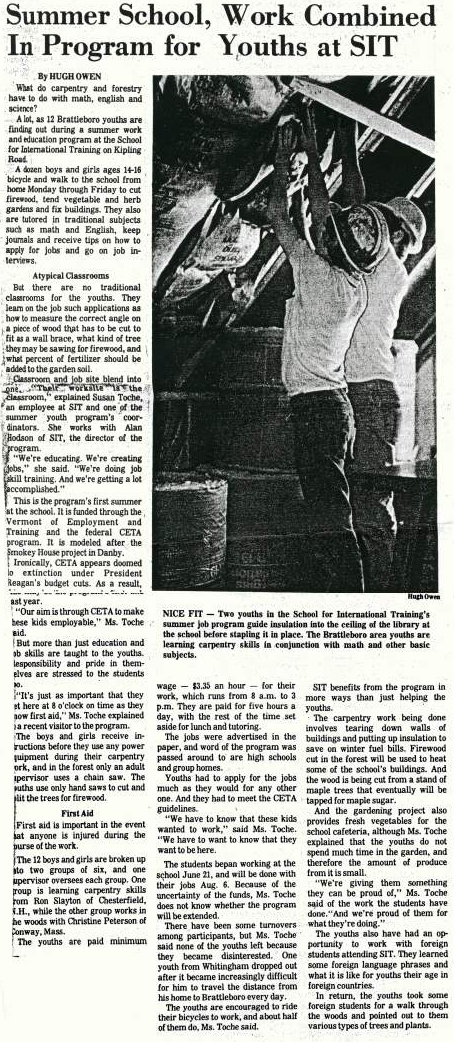Summer School, Work Combined In Program for Youths at SIT
By HUGH OWEN
What do carpentry and forestry have to do with math, english and science? 
A lot, as 12 Brattleboro youths are finding out during a summer work and education program at the School for International Training on Kipling Road.
A dozen boys and girls ages 14-16 bicyde and walk to the school from home Monday through Friday to cut firewood, tend vegetable and herb gardens and fix buildings. They also are tutored in traditional subjects such as math and English, keep journals and receive tips on how to apply for jobs and go on job interviews.
Atypical Classrooms
But there are no traditional classrooms for the youths. They learn on the job such applications as how to measure the correct angle on a piece of wood that has to be cut to fit as a wall brace, what kind of tree they may be sawing for firewood, and what percent of fertilizer should be added to the garden soil.
Classroom and job site blend into one. "Their worksite is the classroom," explained Susan Toch, an employee at SIT and one of the summer youth program's coordinators. She works with Alan Hodson of SIT, the director of the program.
"We're educating. We're creating jobs," she said. "We're doing job skill training. And we're getting a lot accomplished."
This is the program's first summer at the school. It is funded through the Vermont of Employment and Training and the federal CETA program. It is modeled after the Smokey House project in Danby.
I Ironically, CETA appears doomed to extinction under President Reagan's budget cuts. As a result, this may be the program's first and last year.
"Our aim is through CETA to make these kids employable." Ms. Toch said.
But more than just education and job skills are taught to the youths, responsibility and pride in themselves are stressed to the students too.
"It's just as important that they get here at 8 o'clock on time as they know first aid," Ms. Toch explained to a recent visitor to the program.
The boys and girls receive instructions before they use any power equipment during their carpentry work, and in the forest only an adult supervisor uses a chain saw. The youths use only hand saws to cut and split the trees for firewood.
First Aid
First aid is important in the event that anyone is injured during the course of the work.
The 12 boys and girls are broken up into two groups of six, and one supervisor oversees each group. One group is learning carpentry skills from Ron Slayton of Chesterfield, N.H., while the other group works in the woods with Christine Peterson of Conway, Mass.
The youths are paid minimum wage — $3.35 an hour — for their work, which runs from 8 a.m. to 3 p.m. They are paid for five hours a day, with the rest of the time set aside for lunch and tutoring.
The jobs were advertised in the paper, and word of the program was passed around to are high schools and group homes.
Youths had to apply for the jobs much as they would for any other one. And they had to meet the CETA guidelines.
"We have to know that these kids wanted to work," said Ms. Toch. "We have to want to know that they want to be here."
The students began working at the school June 21, and will be done with their jobs Aug. 6. Because of the uncertainty of the funds, Ms. Toch does not know whether the program will be extended.
There have been some turnovers among participants, but Ms. Toch said none of the youths left because they became disinterested. One youth from Whitingham dropped out after it became increasingly difficult for him to travel the distance from his home to Brattleboro every day.
The youths are encouraged to ride their bicycles to work, and about half of them do, Ms. Toch said.
SIT benefits from the program in more ways than just helping the youths.
The carpentry work being done involves tearing down walls of buildings and putting up insulation to save on winter fuel bills. Firewood cut in the forest will be used to heat some of the school's buildings. And the wood is being cut from a stand of maple trees that eventually will be tapped for maple sugar.
And the gardening project also provides fresh vegetables for the school cafeteria, although Ms. Toch explained that the youths do not spend much time in the garden, and therefore the amount of produce from it is small.
"We're giving them something they can be proud of," Ms. Toch said of the work the students have done. "And we're proud of them for what they're doing."
The youths also have had an opportunity to work with foreign students attending SIT. They learned some foreign language phrases and what it is like for youths their age in foreign countries.
In return, the youths took some foreign students for a walk through the woods and pointed out to them various types of trees and plants.
| 